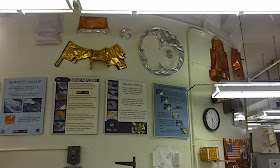 |
| Derek and Kelli at the Cryo-Vacuum Chamber |
STOP 3: GIANT VACUUM CHAMBER
Several critical items related to NASA's next-generation James Webb Space Telescope are being tested in the giant thermal vacuum test chamber. NASA's Space Environment Simulator (SES) is a big vacuum chamber where scientists and engineers cryo-test satellite instruments by lowering the temperature inside to extremes like 42 Kelvin (-384.1 Fahrenheit or -231.1 Celsius) and below to ensure that they can withstand the frigid temperatures of space.
HOW DOES IT WORK? It removes all of the air molecules in the chamber, creating a vacuum. Not only does it test if instruments will work in the extreme cold of space, but it can also heat up! Instruments, like a new car, give off a smell. That smell is called "outgassing." When something gives off gas or a smell, it can damage sensitive mirrors or parts of a satellite, so the vacuum chamber bakes instruments at high temperatures to remove the smell of them.
It's Huge! The part of the chamber that sticks up from the floor we were on is just 1/3rd of the chamber. The rest of it is below ground!
 |
| Thermal space blanket from a shuttle |
STOP 4: MAKING SPACE BLANKETS
A simple NASA technology that protected Apollo and Skylab is still coming to the rescue in space and on Earth. We stopped by the thermal blanket shop at NASA Goddard, where people who worked in the New York garment industry work for NASA, cutting out, sewing and fitting thermal blankets around satellites and spacecraft!
 |
| Standing in front of a shuttle thermal blanket |
The same properties that are critical in space have proved to be life-saving on Earth. NASA's insulation technology has been widely used to create slim thermal blankets, NASA has used the same thin, shining insulation material on virtually all manned and unmanned missions.
Today many marathons use "space blankets" to ward off the post-race chill. The silver-backed crowds of runners have become a well-known symbol of having finished a race.
 | There was a lot more to the tour, but these were just some of the highlights! If you want to know more about what NASA Goddard does, go to: www.nasa.gov/goddard ! |
| Stopping at the "Earth Lights at Night Display! |
